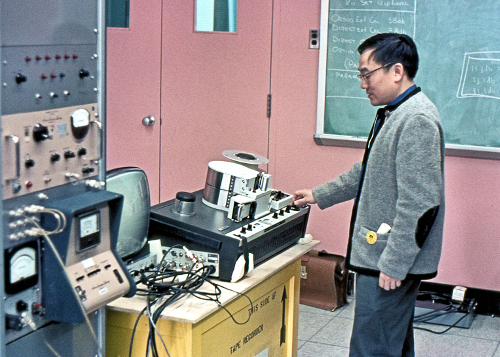
Allen Yen with Ampex VR660 recorder, Prince Albert Radar Lab, February 1968. (Photo courtesy of Joseph R. Fletcher, who says, "Since there is no tape mounted I suspect that Allen was about to take
it apart and tweek something — typical Allen — there was never an adjustment potentiometer that could not be improved upon with a little tweek. It got so bad that we had the ARO mechanic make
a special 'YEN Screwdriver' that had ball bearings in the shaft.")
J.L. (Allen) Yen
Contributed by Wayne Cannon. Text © Royal Society of Canada, used with permission.
J.L. (Allen) Yen, Professor of Electrical Engineering at the University of Toronto and one of the leading figures in Canadian radio astronomy, died suddenly of a brain aneurysm on 30 May 1993 at the age of 68.
Professor Yen was born in Canton China in 1925. He received his B.Sc. degree from Chiao Tung University in 1948. He obtained his M.Sc. and Ph.D. degrees from the University of Toronto Department of Applied Physics in 1950 and 1953 respectively and was appointed to the Faculty of the Department of Electrical Engineering of the University of Toronto in 1952. Professor Yen was promoted to the rank of "Professor" in 1966 and, in recognition of his outstanding research and teaching career, was awarded the title of "University Professor" at University of Toronto in 1980, and held that post until his formal retirement in 1991. Following his formal retirement, Allen Yen continued his work at the University of Toronto as "University Professor Emeritus" until his sudden and untimely death.
Professor Yen's early work in electrical engineering occurred at a time when a researcher could address a range of interesting problems in areas which were later to become the specialized fields of "electronics", "electromagnetics", "computers" and "communications". As a consequence Allen had a very broad grasp of the discipline and could contribute in significant ways to a wide range of research areas on both the theoretical as well as experimental fronts. The breadth and depth of his knowledge also enabled him to contribute significantly to the development of curriculum within his Department. Professor Yen played an important academic role in the transition from the era of vacuum tubes to the era of transistors and digital electronics and was instrumental in developing undergraduate courses in the new emerging disciplines of signal theory, communications, and digital signal processing.
Professor Yen made important contributions to the mathematical theory of reconstructing bandlimited signals from non-uniform samples. These theoretical results are applied to modem day super-high-definition image acquisition systems. Professor Yen also made important research contributions in the areas of electromagnetics, signal theory, and communications. In particular he developed new theoretical advances in the design of high speed modems. However the abiding interest of Professor Yen throughout most of his career was without doubt the application of advanced electrical engineering techniques to the field of radio astronomy. In 1967 Professor Yen was a member of the Canadian team of researchers who first developed the radio astronomical technique of Very Long Baseline Interferometry (VLBI) and was a co-recipient of the Rumford Medal awarded by the American Academy of Arts and Sciences in recognition of the importance of this achievement.
Allen Yen's contributions to the development of the field of VLBI, following the medal winning achievement of its original development, are as varied as they are remarkable. Allen Yen was always very quick to seize upon the new capabilities offered by the development of space technology and to exploit the opportunities that they offered for VLBI development. In one such program Allen was a lead member of a joint Canadian /American team to exploit the use of ANIK-B to provide a reciprocal phase distribution network for the transfer of local oscillator signals to an international array of ground-based VLBI stations in an effort to develop phase coherent VLBI. In a second such program Allen was a lead member of a joint Canadian/American team to use the experimental Canadian "Communications Technology Satellite" (CTS) to develop an operational real-time VLBI link between the 46 meter antenna of the Algonquin Radio Observatory in Algonquin Park Canada and the 140 foot antenna of the National Radio Astronomical Observatory in Green Bank West Virginia. This latter experiment was featured on the cover page of the US magazine Science. Allen was among the first researchers to realize the importance for VLBI science of placing a VLBI radio observatory in Earth orbit and carried out extensive theoretical analysis of this problem. It is a tribute to the farsightedness of Allen Yen to realize that in February of 1997, almost four years after his death and more than twelve years after his original research on the problem, the Japanese Space Agency ISAS, together with Canadian and American ground support, launched a radio telescope into Earth orbit from the Kagoshima launch facilities in southern Japan whose mission was the conduct of astronomical research by space-based VLBI.
Much as Professor Yen would have delighted in the Japanese achievement, had he lived to witness it, he would have delighted even more to see many of his former Canadian colleagues and students playing leading roles in the development of Space VLBI via their participation in this mission. While he is personally missed by a large international cohort of VLBI colleagues, the VLBI legacy of Professor Allen Yen lives on today and is contributing in very significant ways to the furthering of our understanding of the universe in which we live.
![[IAU logo]](iau_wb_thumb.jpg)
![[URSI logo]](URSI-logo-thumb.jpg)
![[Karl Jansky at his antenna]](jansky_photo_02_thumb.jpg)
![[Reber's Wheaton antenna]](Reber_Telescope_Wheaton_thumb.jpg)
![[Dover Heights]](Dover_Heights_02_thumb.jpg)
![[4C telescope]](GB61-195_4C_telescope_thumb.jpg)
![[Ewen and horn antenna]](ewen_horn1s.jpg)
![[Dwingeloo, 1956]](Dwingeloo-1956-thumb.jpg)
![[Jocelyn Bell Burnell and Cambridge antenna used in pulsar discovery]](burnell2_thumb.jpg)
![[Lovell Telescope at Jodrell Bank]](site_1594_0001-500-334-20180316163019-thumb150.jpg)
![[Wilson, Penzias, and Bell Labs horn antenna]](wilson-penzias-horn_thumb.jpg)
![[6-m Millimeter Radio Telescope in Mitaka, Japan]](6m-thumb.jpg)

